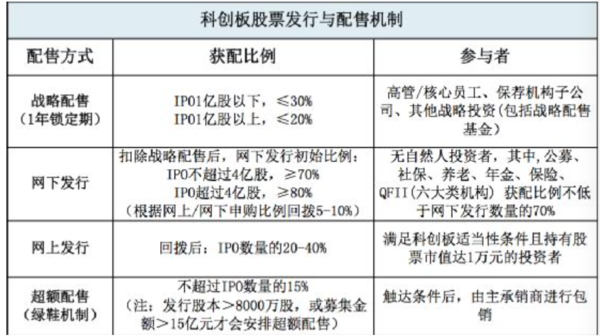On How can I buy a science and technology innovation board fund that starts at 1 yuan? Understand one article In this article about Science and Technology Innovation Board Fund, we introduce a Science and technology innovation board "innovation" hybrid fund.
Today, let's talk about the advantages of this kind of participation in new public funds and other science and technology innovation board theme funds? How to choose?
1. What are the advantages of participating in new offline public funds?
There is no harm without comparison. There are two ways for public funds to participate in the innovation of science and technology innovation board - strategic placement and offline innovation. Let's compare the differences between the two in the innovation rules.
First, let's talk about the allocation ratio.
Although everyone is involved in the fight for new public funds, the distribution ratio under different placement mechanisms is different. See the following table for details

The above figure is sorted out according to the suggestions of the Self discipline Committee of Shanghai Stock Exchange for the Public Issuance of Science and Technology Innovation Board on June 8. Some of the partners may feel that the above table is not easy to understand. Don't worry, let me explain it briefly.
According to the regulations, the share of the science and technology innovation board is mainly divided into three parts: strategic allocation, offline and online.
If the initial offering is more than 100 million shares, The proportion of strategic allocation shall not exceed 30% If the initial offering is less than 100 million shares, Strategic placement shall not exceed 20% (Note: Public funds are only a part of strategic placement participants)
After talking about strategic placement, let's look at offline innovation. If the number of shares issued does not exceed 400 million, the proportion of offline initial allocation shall not be less than 70%; If the number of shares issued exceeds 400 million or has not yet made a profit, the proportion of offline initial allocation shall not be less than 80%. In view of the fact that most of the new stocks on the Science and Technology Innovation Board are small in size, we will calculate them based on 70% of the overall offline allocation ratio.
At present, the total number of offline innovation institutions is about 2000-3000, including about 1500 public funds, accounting for 50%. in other words, 50% * 70%=35% can be allocated for participating in offline new public funds.
In this view, the allocation proportion of public funds participating in offline new offering is far higher than that of strategic public funds.
Next, let's talk about liquidity.
For strategic placement, as the name implies, your participation means that you are a strategic investor, that is, you invest with a long-term holding and long-term optimistic attitude. Because of this, the lock up period of stocks allocated through strategic placement is more than 12 months, while for investment in strategic placement funds, there is a 3-year lock up period, which is a little unfriendly to impatient partners.
For offline innovation, there is no such strict restriction. Just lock 10% of the total number of shares allocated for 6 months, and other shares can be bought and sold at any time. As for the public offering funds participating in offline creation, they can be traded at any time, just like the funds we invest in on weekdays. There is no limit unless the announcement is made to suspend redemption or limit large amounts.
In contrast, the liquidity of public funds participating in offline placements is much better than that of strategic placements, and they no longer need to look forward to the opening period.
2. How about the income of new public funds offline?
Whether we can make money is the most important thing. Now let's talk about the income measurement of offline new funds. Before that, I would like to emphasize that even if we participate in the innovation of the science and technology innovation board, and in order to change the nature of its funds, the profits and losses are still volatile, and the fund income is not guaranteed, so we need to treat it objectively.
Get to the point.
After the offline innovation fund participates in the innovation of the science and technology innovation board, it will bring increased income. It is equivalent to bringing an extra excess return to the fund. So, how much can this excess return be?
Again, let's sort out the preconditions mentioned above:
1) Among offline institutional investors, public funds account for about 50%;
2) The average proportion of strategic distribution is 20%, and the average proportion of offline issuance (excluding strategic distribution and after-sales) is 70%;
3) The number of public funds allocated accounts for half of the number of offline offerings, i.e. 70% * 50%=35%;
4) Assume that 10% of the shares are selected and locked for 6 months, that is, the new income is estimated at 90% of the allocated amount;
5) To participate in offline new public offering funds, 60 million Shanghai stock bottom positions and 10 million Shenzhen stock bottom positions are required.
According to the above conditions, we calculate the increase income based on the average increase of 50%, 80% and 100% of the stock of the Science and Technology Innovation Board. The results are as follows

As far as the rule of offline innovation is concerned, the absolute return of each participating public offering fund is basically the same, but the excess return rate caused by different fund sizes is different. Without considering the fluctuation of the bottom position, the smaller the size, the better, so that the greater the excess return rate that the absolute return can contribute.
However, in fact, if the size is too small, if the bottom position is not selected well, or the overall volatility of the A-share market is large, the excess return of new shares will also be offset obviously.
On the contrary, if the size of the fund is too large, the increase of eight million yuan will only be a contribution to the overall yield of a few decimal places, which is not worth mentioning.
3. How to select high-quality offline new funds?
First of all, this kind of fund is still an active management fund, and the basic basis selection method is similar to our previous selection of active funds. Young partners should also pay attention to the allocation of bottom positions by fund managers. Generally speaking, prudent investors should try to choose blue chip or leading funds for bottom positions, so that the stability of overall returns will be higher.
In addition, another important aspect is the size of the fund. We suggest to choose a fund with a size of about 200 million or 300 million, which can better reflect the benefits of innovation and enrichment.



